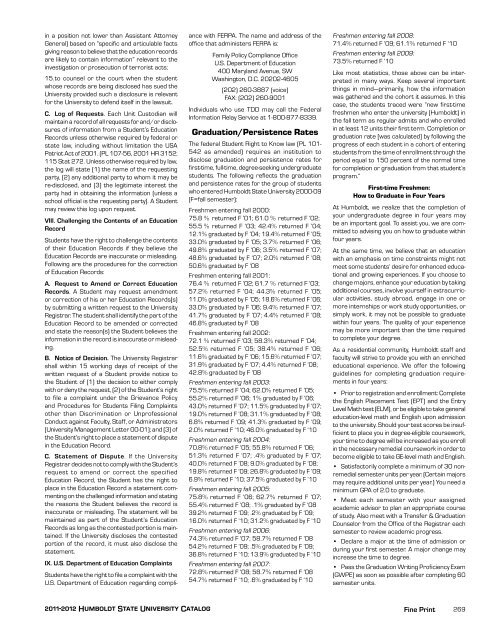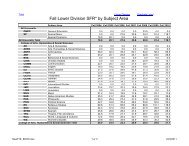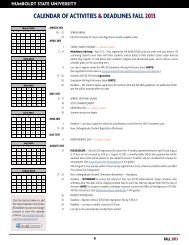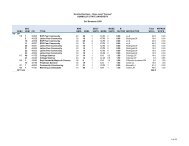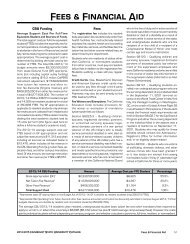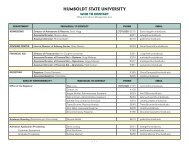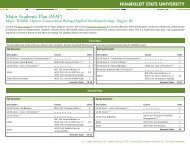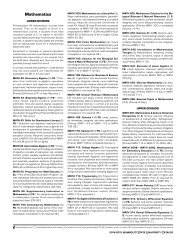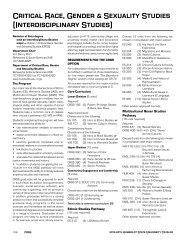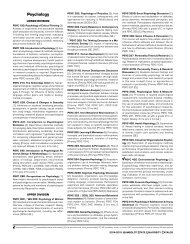2011-12 Academic Year - Bad Request - Humboldt State University
2011-12 Academic Year - Bad Request - Humboldt State University
2011-12 Academic Year - Bad Request - Humboldt State University
Create successful ePaper yourself
Turn your PDF publications into a flip-book with our unique Google optimized e-Paper software.
in a position not lower than Assistant Attorney<br />
General) based on “specific and articulable facts<br />
giving reason to believe that the education records<br />
are likely to contain information” relevant to the<br />
investigation or prosecution of terrorist acts;<br />
15. to counsel or the court when the student<br />
whose records are being disclosed has sued the<br />
<strong>University</strong> provided such a disclosure is relevant<br />
for the <strong>University</strong> to defend itself in the lawsuit.<br />
C. Log of <strong>Request</strong>s. Each Unit Custodian will<br />
maintain a record of all requests for and/or disclosures<br />
of information from a Student’s Education<br />
Records unless otherwise required by federal or<br />
state law, including without limitation the USA<br />
Patriot Act of 2001. (PL 107-56, 2001 HR 3152;<br />
115 Stat 272. Unless otherwise required by law,<br />
the log will state (1) the name of the requesting<br />
party, (2) any additional party to whom it may be<br />
re-disclosed, and (3) the legitimate interest the<br />
party had in obtaining the information (unless a<br />
school official is the requesting party). A Student<br />
may review this log upon request.<br />
VIII. Challenging the Contents of an Education<br />
Record<br />
Students have the right to challenge the contents<br />
of their Education Records if they believe the<br />
Education Records are inaccurate or misleading.<br />
Following are the procedures for the correction<br />
of Education Records:<br />
A. <strong>Request</strong> to Amend or Correct Education<br />
Records. A Student may request amendment<br />
or correction of his or her Education Records(s)<br />
by submitting a written request to the <strong>University</strong><br />
Registrar. The student shall identify the part of the<br />
Education Record to be amended or corrected<br />
and state the reason(s) the Student believes the<br />
information in the record is inaccurate or misleading.<br />
B. Notice of Decision. The <strong>University</strong> Registrar<br />
shall within 15 working days of receipt of the<br />
written request of a Student provide notice to<br />
the Student of (1) the decision to either comply<br />
with or deny the request, (2) of the Student’s right<br />
to file a complaint under the Grievance Policy<br />
and Procedures for Students Filing Complaints<br />
other than Discrimination or Unprofessional<br />
Conduct against Faculty, Staff, or Administrators<br />
(<strong>University</strong> Management Letter 00-01); and (3) of<br />
the Student’s right to place a statement of dispute<br />
in the Education Record.<br />
C. <strong>State</strong>ment of Dispute. If the <strong>University</strong><br />
Registrar decides not to comply with the Student’s<br />
request to amend or correct the specified<br />
Education Record, the Student has the right to<br />
place in the Education Record a statement commenting<br />
on the challenged information and stating<br />
the reasons the Student believes the record is<br />
inaccurate or misleading. The statement will be<br />
maintained as part of the Student’s Education<br />
Records as long as the contested portion is maintained.<br />
If the <strong>University</strong> discloses the contested<br />
portion of the record, it must also disclose the<br />
statement.<br />
IX. U.S. Department of Education Complaints<br />
Students have the right to file a complaint with the<br />
U.S. Department of Education regarding compli-<br />
<strong>2011</strong>-20<strong>12</strong> <strong>Humboldt</strong> <strong>State</strong> <strong>University</strong> Catalog<br />
ance with FERPA. The name and address of the<br />
office that administers FERPA is:<br />
Family Policy Compliance Office<br />
U.S. Department of Education<br />
400 Maryland Avenue, SW<br />
Washington, D.C. 20202-4605<br />
(202) 260-3887 (voice)<br />
FAX: (202) 260-9001<br />
Individuals who use TDD may call the Federal<br />
Information Relay Service at 1-800-877-8339.<br />
Graduation/Persistence Rates<br />
The federal Student Right to Know law (PL 101-<br />
542 as amended) requires an institution to<br />
disclose graduation and persistence rates for<br />
first-time, full-time, degree-seeking undergraduate<br />
students. The following reflects the graduation<br />
and persistence rates for the group of students<br />
who entered <strong>Humboldt</strong> <strong>State</strong> <strong>University</strong> 2000-09<br />
(F=fall semester):<br />
Freshmen entering fall 2000:<br />
75.8 % returned F ‘01; 61.0 % returned F ‘02;<br />
55.5 % returned F ‘03; 42.4% returned F ‘04;<br />
<strong>12</strong>.1% graduated by F ‘04; 19.4% returned F ‘05;<br />
33.0% graduated by F ‘05; 3.7% returned F ‘06;<br />
49.8% graduated by F ‘06; 3.5% returned F ‘07;<br />
48.6% graduated by F ‘07; 2.0% returned F ‘08;<br />
50.6% graduated by F ‘08<br />
Freshmen entering fall 2001:<br />
76.4 % returned F ‘02; 61.7 % returned F ‘03;<br />
57.2% returned F ‘04; 44.3% returned F ‘05;<br />
11.0% graduated by F ‘05; 18.6% returned F ‘06;<br />
33.0% graduated by F ‘06; 9.4% returned F ‘07;<br />
41.7% graduated by F ‘07; 4.4% returned F ‘08;<br />
46.8% graduated by F ‘08<br />
Freshmen entering fall 2002:<br />
72.1 % returned F ‘03; 58.3% returned F ‘04;<br />
52.5% returned F ‘05; 38.4% returned F ‘06;<br />
11.6% graduated by F ‘06; 15.6% returned F ‘07;<br />
31.9% graduated by F ‘07; 4.4% returned F ‘08;<br />
42.8% graduated by F ‘08<br />
Freshmen entering fall 2003:<br />
75.5% returned F ‘04; 62.0% returned F ‘05;<br />
55.2% returned F ‘06; 1% graduated by F ‘06;<br />
43.0% returned F ‘07; 11.5% graduated by F ‘07;<br />
19.0% returned F ‘08; 31.1% graduated by F ‘08;<br />
6.8% returned F ‘09; 41.3% graduated by F ‘09;<br />
2.0% returned F ‘10; 46.0% graduated by F ‘10<br />
Freshmen entering fall 2004:<br />
70.8% returned F ‘05; 55.8% returned F ‘06;<br />
51.3% returned F ‘07; .4% graduated by F ‘07;<br />
40.0% returned F ‘08; 9.0% graduated by F ‘08;<br />
19.8% returned F ‘09; 26.8% graduated by F ‘09;<br />
6.9% returned F ‘10; 37.5% graduated by F ‘10<br />
Freshmen entering fall 2005:<br />
75.8% returned F ‘06; 62.7% returned F ‘07;<br />
55.4% returned F ‘08; .1% graduated by F ‘08<br />
39.2% returned F ‘09; .2% graduated by F ‘09;<br />
16.0% returned F ‘10; 31.2% graduated by F ‘10<br />
Freshmen entering fall 2006:<br />
74.3% returned F ‘07; 58.7% returned F ‘08<br />
54.2% returned F ‘09; .5% graduated by F ‘09;<br />
36.8% returned F ‘10; 13.9% graduated by F ‘10<br />
Freshmen entering fall 2007:<br />
72.8% returned F ‘08; 58.7% returned F ‘08<br />
54.7% returned F ‘10; .6% graduated by F ‘10<br />
Freshmen entering fall 2008:<br />
71.4% returned F ‘09; 61.1% returned F ‘10<br />
Freshmen entering fall 2009:<br />
73.5% returned F ‘10<br />
Like most statistics, those above can be interpreted<br />
in many ways. Keep several important<br />
things in mind—primarily, how the information<br />
was gathered and the cohort it assumes. In this<br />
case, the students traced were “new first-time<br />
freshmen who enter the university (<strong>Humboldt</strong>) in<br />
the fall term as regular admits and who enrolled<br />
in at least <strong>12</strong> units their first term. Completion or<br />
graduation rate [was calculated] by following the<br />
progress of each student in a cohort of entering<br />
students from the time of enrollment through the<br />
period equal to 150 percent of the normal time<br />
for completion or graduation from that student’s<br />
program.”<br />
First-time Freshmen:<br />
How to Graduate in Four <strong>Year</strong>s<br />
At <strong>Humboldt</strong>, we realize that the completion of<br />
your undergraduate degree in four years may<br />
be an important goal. To assist you, we are committed<br />
to advising you on how to graduate within<br />
four years.<br />
At the same time, we believe that an education<br />
with an emphasis on time constraints might not<br />
meet some students’ desire for enhanced educational<br />
and growing experiences. If you choose to<br />
change majors, enhance your education by taking<br />
additional courses, involve yourself in extracurricular<br />
activities, study abroad, engage in one or<br />
more internships or work study opportunities, or<br />
simply work, it may not be possible to graduate<br />
with in four years. The quality of your experience<br />
may be more important than the time required<br />
to complete your degree.<br />
As a residential community, <strong>Humboldt</strong> staff and<br />
faculty will strive to provide you with an enriched<br />
educational experience. We offer the following<br />
guidelines for completing graduation requirements<br />
in four years:<br />
• Prior to registration and enrollment: Complete<br />
the English Placement Test (EPT) and the Entry<br />
Level Math test (ELM), or be eligi ble to take general<br />
education-level math and English upon admission<br />
to the university. Should your test scores be insufficient<br />
to place you in degree-eligible coursework,<br />
your time to degree will be increased as you enroll<br />
in the necessary remedial coursework in order to<br />
become eligible to take GE-level math and English.<br />
• Satisfactorily complete a minimum of 30 nonremedial<br />
semester units per year. (Certain majors<br />
may require additional units per year.) You need a<br />
minimum GPA of 2.0 to graduate.<br />
• Meet each semester with your assigned<br />
academic advisor to plan an appropriate course<br />
of study. Also meet with a Transfer & Graduation<br />
Counselor from the Office of the Registrar each<br />
semester to review academic progress.<br />
• Declare a major at the time of admission or<br />
during your first semester. A major change may<br />
increase the time to degree.<br />
• Pass the Graduation Writing Proficiency Exam<br />
(GWPE) as soon as possible after completing 60<br />
semester units.<br />
Fine Print<br />
269


